Drugs of Anti-Parkinson’s disease - 汕头大学医学院
获得性长QT间期综合征的防治建议
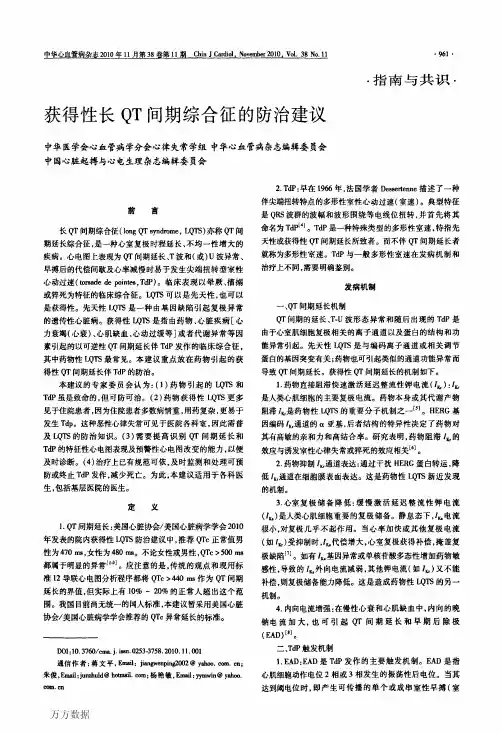
・964・TdP发作的心电图预警参数某腾心电图改变可以作为预警信号提示TdP的发生。
应注意这些典型的心电图预警表现往往呈动态变化。
同一患者不同时间的心电图变化不同,尤其是T-u波的畸形,往往随着心动周期的变化而变化,需要动态监测才能发现。
I.QTc间期延长:在先天性LQls患者中,QTc每增加10咖使TdP的发生危险呈5%一7%指数性的增加旧彤1。
啦>500Ills者TdP的发生危险增加2~3倍。
药物诱发帆>500rn¥时,TdP的危险也同样增加¨…。
但目前没有一个明确的可诱发TdP的QTc阈值。
尽管对于先天性LQTs的研究显示,发生晕厥和猝死的危险与QT间期长短有直接的关系惮J,但只靠监测QT/QTc间期来预测TdP是不够的惭J,还需注意下述其他心电图改变。
2.T-U波畸形和间歇依赖现象:T・u波形态异常通常包括T波低平、双向、u波加大并与T波融合、T波降支逐渐下降并时限延长,使T波的末端难以辨认。
一些报道指出,T波波峰至T波终末(Tp—Te)时程代表着整个心脏最早和最迟复极完毕的时间问期。
Tp-Te延长是心肌复极离散度增加的表现,容易发生TdP惭。
J。
药物诱发的LQ,rs患者,在正常窦性心律时可能没有不良效应。
但在TclP开始前可出现典型的短一长-短RR问期(间歇依赖现象),即长间歇后心搏的QT间期明显延长,T.u波形态也明显异常。
电生理研究表明,间歇后心搏的异常T—U波的振幅与间歇的长度和间歇前的心率有关嘲J。
出现长间歇的原因最可能是早搏的代偿问期,暂时性的窦性停搏或房室传导阻滞,但也可能是变化十分微小的窦性心律不齐。
这种不同心搏之间的QT间期不稳定性与心律失常发生的机制有关旧J。
由此而产生的显著QT问期延长和T.u波形态异常可以触发窜早,从而再次产生长间歇,直至TdP的发生。
因此心脏间歇后出现显著的QT间期延长和T.U波形态异常应当认为是发生TdP的强预警信号。
这种间歇依赖现象虽可在12导联心电图中记录到,但更常见于监测心电图(图I)。
成人斯蒂尔病文献
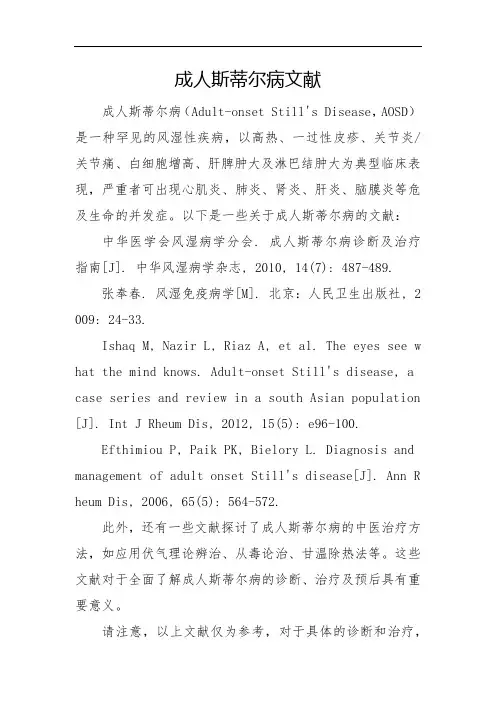
成人斯蒂尔病文献
成人斯蒂尔病(Adult-onset Still's Disease,AOSD)是一种罕见的风湿性疾病,以高热、一过性皮疹、关节炎/关节痛、白细胞增高、肝脾肿大及淋巴结肿大为典型临床表现,严重者可出现心肌炎、肺炎、肾炎、肝炎、脑膜炎等危及生命的并发症。
以下是一些关于成人斯蒂尔病的文献:中华医学会风湿病学分会. 成人斯蒂尔病诊断及治疗指南[J]. 中华风湿病学杂志, 2010, 14(7): 487-489.
张奉春. 风湿免疫病学[M]. 北京:人民卫生出版社, 2 009: 24-33.
Ishaq M, Nazir L, Riaz A, et al. The eyes see w hat the mind knows. Adult-onset Still's disease, a case series and review in a south Asian population [J]. Int J Rheum Dis, 2012, 15(5): e96-100.
Efthimiou P, Paik PK, Bielory L. Diagnosis and management of adult onset Still's disease[J]. Ann R heum Dis, 2006, 65(5): 564-572.
此外,还有一些文献探讨了成人斯蒂尔病的中医治疗方法,如应用伏气理论辨治、从毒论治、甘温除热法等。
这些文献对于全面了解成人斯蒂尔病的诊断、治疗及预后具有重要意义。
请注意,以上文献仅为参考,对于具体的诊断和治疗,
建议咨询专业医生或风湿病专家。
罂粟碱治疗早期糖尿病足的临床疗效及对患者炎症反应的影响
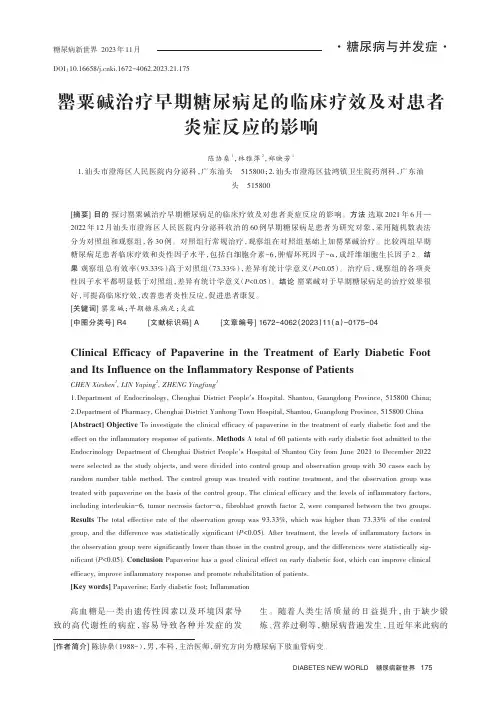
罂粟碱治疗早期糖尿病足的临床疗效及对患者炎症反应的影响陈协燊1,林雅萍2,郑映芳11.汕头市澄海区人民医院内分泌科,广东汕头515800;2.汕头市澄海区盐鸿镇卫生院药剂科,广东汕头515800[摘要]目的探讨罂粟碱治疗早期糖尿病足的临床疗效及对患者炎症反应的影响。
方法选取2021年6月—2022年12月汕头市澄海区人民医院内分泌科收治的60例早期糖尿病足患者为研究对象,采用随机数表法分为对照组和观察组,各30例。
对照组行常规治疗,观察组在对照组基础上加罂粟碱治疗。
比较两组早期糖尿病足患者临床疗效和炎性因子水平,包括白细胞介素-6,肿瘤坏死因子-α,成纤维细胞生长因子2。
结果观察组总有效率(93.33%)高于对照组(73.33%),差异有统计学意义(P<0.05)。
治疗后,观察组的各项炎性因子水平都明显低于对照组,差异有统计学意义(P<0.05)。
结论罂粟碱对于早期糖尿病足的治疗效果很好,可提高临床疗效,改善患者炎性反应,促进患者康复。
[关键词] 罂粟碱;早期糖尿病足;炎症[中图分类号] R4 [文献标识码] A [文章编号] 1672-4062(2023)11(a)-0175-04Clinical Efficacy of Papaverine in the Treatment of Early Diabetic Foot and Its Influence on the Inflammatory Response of PatientsCHEN Xieshen1, LIN Yaping2, ZHENG Yingfang11.Department of Endocrinology, Chenghai District People's Hospital, Shantou, Guangdong Province, 515800 China;2.Department of Pharmacy, Chenghai District Yanhong Town Hospital, Shantou, Guangdong Province, 515800 China[Abstract] Objective To investigate the clinical efficacy of papaverine in the treatment of early diabetic foot and the effect on the inflammatory response of patients. Methods A total of 60 patients with early diabetic foot admitted to the Endocrinology Department of Chenghai District People's Hospital of Shantou City from June 2021 to December 2022 were selected as the study objects, and were divided into control group and observation group with 30 cases each by random number table method. The control group was treated with routine treatment, and the observation group was treated with papaverine on the basis of the control group. The clinical efficacy and the levels of inflammatory factors, including interleukin-6, tumor necrosis factor-α, fibroblast growth factor 2, were compared between the two groups.Results The total effective rate of the observation group was 93.33%, which was higher than 73.33% of the control group, and the difference was statistically significant (P<0.05). After treatment, the levels of inflammatory factors in the observation group were significantly lower than those in the control group, and the differences were statistically sig⁃nificant (P<0.05). Conclusion Papaverine has a good clinical effect on early diabetic foot, which can improve clinical efficacy, improve inflammatory response and promote rehabilitation of patients.[Key words] Papaverine; Early diabetic foot; Inflammation高血糖是一类由遗传性因素以及环境因素导致的高代谢性的病症,容易导致各种并发症的发生。
登革热诊断与治疗
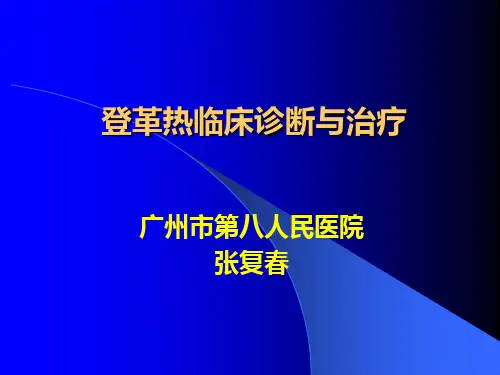
0
1.4% 2006
本地感染病例
输入性病例
输入病例比例
78.6%
6.7% 2007
29.0%
2008
2009
87.5% 2010
100.0% 90.0% 80.0% 70.0% 60.0% 50.0% 40.0% 30.0% 20.0% 10.0% 0.0%
2011年全国登革热本地感染与输入性病例地理分布
发病月份分布,1990-2010
病例数
7000 6000
6227
5000
8~10月报告病例占92.4%
4000
7~11月报告病例占99.1% 3293
3000
2808
2000
1000
340
5
2
3
8
11
37
0
560 52
1
2
3
4
5
6
7
8
9
10 11 12
月份
登革热病例年龄分布
广东省登革热疫情特点
Байду номын сангаас
高热
明显出血倾向
血液浓缩
血小板减少
血浆渗漏表现:
腹胸水、胆囊壁增厚
低蛋白血症
HCT超过正常值20%以上
登革出血热严重程度分级
Ⅰ级:有发热、皮疹、束臂试验阳性、 血小板减少、血液浓缩等
Ⅱ级:除有Ⅰ级的表现外,伴有出血 Ⅲ级:有轻中度休克(血压下降、脉速、
皮肤湿冷、烦躁等 Ⅳ级: 休克程度深,血压和脉搏测不出
好的事情马上就会到来,一切都是最 好的安 排。上 午6时29 分10秒 上午6 时29分0 6:29:10 20.11.2
国家药品监督管理局药品行政保护公告第146号(终止公告)
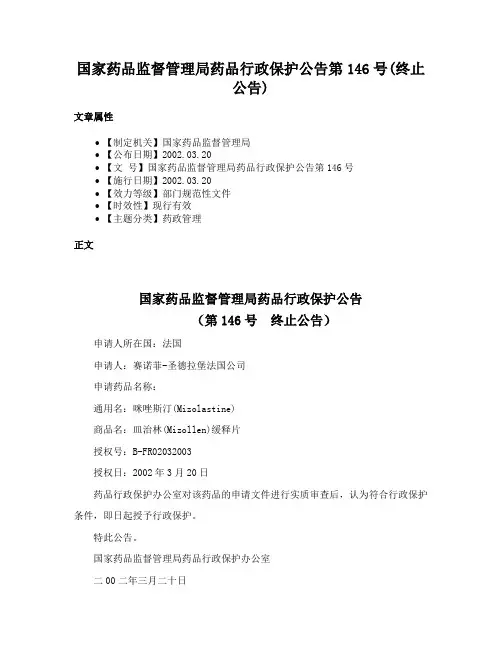
国家药品监督管理局药品行政保护公告第146号(终止
公告)
文章属性
•【制定机关】国家药品监督管理局
•【公布日期】2002.03.20
•【文号】国家药品监督管理局药品行政保护公告第146号
•【施行日期】2002.03.20
•【效力等级】部门规范性文件
•【时效性】现行有效
•【主题分类】药政管理
正文
国家药品监督管理局药品行政保护公告
(第146号终止公告)
申请人所在国:法国
申请人:赛诺菲-圣德拉堡法国公司
申请药品名称:
通用名:咪唑斯汀(Mizolastine)
商品名:皿治林(Mizollen)缓释片
授权号:B-FR02032003
授权日:2002年3月20日
药品行政保护办公室对该药品的申请文件进行实质审查后,认为符合行政保护条件,即日起授予行政保护。
特此公告。
国家药品监督管理局药品行政保护办公室
二00二年三月二十日。
帕金森病与神经炎症关系的研究进展
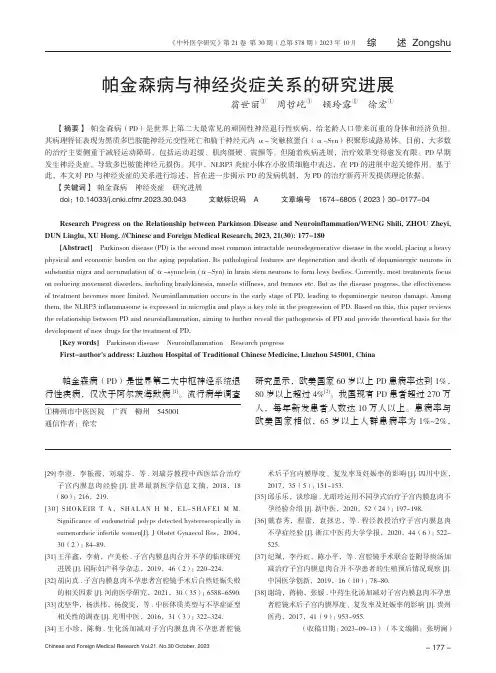
- 177 -[29]李澄,李振霞,刘瑞芬,等.刘瑞芬教授中西医结合治疗子宫内膜息肉经验[J].世界最新医学信息文摘,2018,18(80):216,219.[30] SHOKEIR T A,SHALAN H M,EL-SHAFEI M M.Significance of endometrial polyps detected hysteroscopically in eumenorrheic infertile women[J]. J Obstet Gynaecol Res,2004,30(2):84-89.[31]王洋鑫,李萌,卢美松.子宫内膜息肉合并不孕的临床研究进展[J].国际妇产科学杂志,2019,46(2):220-224.[32]胡向真.子宫内膜息肉不孕患者宫腔镜手术后自然妊娠失败的相关因素[J].河南医学研究,2021,30(35):6588-6590.[33]沈坚华,杨洪伟,杨俊雯,等.中医体质类型与不孕症证型相关性的调查[J].光明中医,2016,31(3):322-324.[34]王小珍,陈梅.生化汤加减对子宫内膜息肉不孕患者腔镜术后子宫内膜厚度、复发率及妊娠率的影响[J].四川中医,2017,35(5):151-153.[35]邱乐乐,谈珍瑜.尤昭玲运用不同孕式治疗子宫内膜息肉不孕经验介绍[J].新中医,2020,52(24):197-198.[36]戴春秀,程蕾,袁拯忠,等.程泾教授治疗子宫内膜息肉不孕症经验[J].浙江中医药大学学报,2020,44(6):522-525.[37]纪珮,李丹虹,陈小平,等.宫腔镜手术联合苍附导痰汤加减治疗子宫内膜息肉合并不孕患者的生殖预后情况观察[J].中国医学创新,2019,16(10):78-80.[38]谢绮,蒋楠,张媛.中药生化汤加减对子宫内膜息肉不孕患者腔镜术后子宫内膜厚度、复发率及妊娠率的影响[J].贵州医药,2017,41(9):953-955.(收稿日期:2023-09-13) (本文编辑:张明澜)①柳州市中医医院 广西 柳州 545001通信作者:徐宏帕金森病与神经炎症关系的研究进展翁世丽① 周哲屹① 顿玲露① 徐宏① 【摘要】 帕金森病(PD)是世界上第二大最常见的顽固性神经退行性疾病,给老龄人口带来沉重的身体和经济负担。
度洛西汀与艾司西酞普兰治疗抑郁症患者临床效果及安全性的比较
CHINA MODERN MEDICINE Vol.28No.1January 2021流行数据调查指出,精神科的患病比例呈明显上升态势。
分析导致精神科疾病多发的原因,与社会生活节奏的加快、工作以及生活压力的增大、遗传等因素有关。
抑郁症是精神科的多发疾病典型类型,其度洛西汀与艾司西酞普兰治疗抑郁症患者临床效果及安全性的比较张琎辽宁省锦州市康宁医院躯体疾病科,辽宁锦州121000[摘要]目的比较度洛西汀、艾司西酞普兰治疗抑郁症患者的临床效果及安全性,以期为精神科抑郁症疾病治疗提供参考。
方法选取2018年2月~2020年2月锦州市康宁医院精神科收治的120例抑郁症患者作为研究对象,采用随机数字表法将患者分为对照组与观察组,每组各60例。
对照组患者采取艾司西酞普兰治疗,观察组患者采取度洛西汀治疗。
比较两组患者的治疗预后效果,包括治疗总有效率、不良反应总发生率及抑郁评分。
结果观察组患者的总有效率高于对照组,差异有统计学意义(P <0.05)。
观察组患者的不良反应总发生率低于对照组,差异有统计学意义(P <0.05)。
两组患者治疗前的抑郁评分比较,差异无统计学意义(P >0.05)。
治疗后1、2、4、8周,观察组患者的抑郁评分低于对照组,差异有统计学意义(P <0.05)。
结论度洛西汀与艾司西酞普兰均可用于抑郁症治疗,但是治疗效果、安全性、症状改善情况等比较,度洛西汀优势明显,是优选治疗药物。
[关键词]度洛西汀;艾司西酞普兰;抑郁症;治疗效果;安全性[中图分类号]R749.4[文献标识码]A[文章编号]1674-4721(2021)1(a)-0000-03Comparison of clinical effect and safety of Duloxetine and Escitalopram in the treatment of patients with depressionZHANG JinDepartment of Somatic Diseases,Jinzhou Kangning Hospital,Liaoning Province,Jinzhou 121000,China[Abstract]Objective To compare the clinical effect and safety of Duloxetine and Escitalopram in the treatment of pa⁃tients with depression,so as to provide reference for the treatment of psychiatric depression.Methods A total of 120patients with depression admitted to the Department of Psychiatric of Jinzhou Kangning Hospital from February 2018to February 2020were selected as the research objects,and the patients were divided into the control group and the ob⁃servation group by the random number table method,with 60patients in each group.Patients in the control group were treated with Escitalopram,while patients in the observation group were treated with Duloxetine.The prognostic out⁃comes of the two groups were compared,including the total effective rate of treatment,the total incidence of adversereactions and the depression score.Results The total effective rate of patients in the observation group was higher thanthat in the control group,and the difference was statistically significant (P <0.05).The total incidence of adverse reac⁃tions in the observation group was lower than that in the control group,with statistically significant difference (P <0.05).There was no significant difference in depression score between the two groups before treatment (P >0.05).At 1,2,4,and 8weeks after treatment,the depression scores of patients in the observation group were lower than those in the control group,with statistically significant differences (P <0.05).Conclusion Both Duloxetine and Escitalopram can be used in the treatment of depression.However,compared with the treatment effect,safety and symptom improvement,Duloxetine has obvious advantages and is the preferred therapeutic drug.[Key words]Duloxetine;Escitalopram;Depression;Treatment effect;Safety[作者简介]张琎(1985-),女,汉族,山东牟平人,本科,主治医师,研究方向:精神科疾病59中女性的患病率较高,是严重的公共卫生问题,患者有明显的抑郁情绪表现,需积极用药治疗,以提高患者自身和他人的安全性[1]。
Parkinson’s disease
Parkinson’s diseaseParkinson's disease (PD) is a degenerative disorder of the central nervous system. The motor symptoms of Parkinson's disease result from the death ofdopamine-generating cells in the substantia nigra, a region of the midbrain; the cause of this cell death is unknown. Early in the course of the disease, the most obvious symptoms are movement-related; these include shaking, rigidity, slowness of movementand difficulty with walking and gait. Later, thinking and behavioral problems may arise, with dementia commonly occurring in the advanced stages ofthe disease, whereas depression is the most common psychiatric symptom. Other symptoms include sensory, sleep and emotional problems. Parkinson's disease is more common in older people, with most cases occurring after the age of 50. Signs and symptoms of Parkinson's diseaseParkinson's disease affects movement, producing motor symptoms. Non-motor symptoms, which include autonomic dysfunction,neuropsychiatric problems (mood, cognition, behavior or thought alterations), and sensory and sleep difficulties, are also common. Some of these non-motor symptoms are often present at the time of diagnosis and can precede motor symptoms. Four motor symptoms are considered cardinal in PD: tremor, rigidity, slowness of movement, and postural instability. Parkinson's disease can cause neuropsychiatric disturbances which can range from mild to severe. This includes disorders of speech, cognition, mood, behaviour, and thought. In addition to cognitive and motor symptoms, PD can impair other body functions. Sleep problems are a feature of the disease and can be worsened by medications. All of these symptoms can occur years before diagnosis of the disease. Causes of Parkinson's diseaseParkinson's disease in most people is idiopathic (having no specific known cause). However a small proportion of cases, can be attributed to known genetic factors. Other factors have been associated with the risk of developing PD, but no causal relationships have been proven.Environmental factorsA number of environmental factors have been associated with an increased riskof Parkinson's including: pesticide exposure, head injuries, and living in the countryor farming. Rural environments and the drinking of well water may be risks as theyare an indirect measures of exposure to pesticides.GeneticsPD traditionally has been considered a non-genetic disorder; however, around 15% of individuals with PD have a first-degree relative who has the disease .At least 5% of people are now known to have forms of the disease that occur because of a mutation of one of several specific genes.PreventionCaffeine consumption appears protective against Parkinson's disease with a greater decrease in risk occurring with a larger intake of caffeinated beverages such as coffee. Although tobacco smoke decreases life expectancy and quality of life, it may reduce the risk of PD by a third when compared to non-smokers. The basis for this effect is not known, but possibilities include an effect of nicotine as a dopamine stimulant. Tobacco smoke contains compounds that act as MAO inhibitors that also might contribute to this effect.Antioxidants, such as vitamins C and D, have been proposed to protect against the disease but results of studies have been contradictory and no positive effect has been proven. The results regarding fat and fatty acids have been contradictory, with various studies reporting protective effects, risk-increasing effects or no effects. Finally there have been preliminary indications of a possible protective role of estrogens and anti-inflammatory drugs.TreatmentThere is no cure for Parkinson's disease, but medications, surgery and multidisciplinary management can provide relief from the symptoms. The main families of drugs useful for treating motor symptoms are levodopa (usually combined with a dopa decarboxylase inhibitor or COMT inhibitor), dopamine agonists and MAO-B inhibitors. The stage of the disease determines which group is most useful. Two stages are usually distinguished: an initial stage in which the individual with PD has already developed some disability for which he needs pharmacological treatment, then a second stage in which an individual develops motor complications related to levodopa usage. Treatment in the initial stage aims for an optimal tradeoff between good symptom control and side-effects resulting from improvement of dopaminergic function. The start of levodopa (or L-DOPA) treatment may be delayed by using other medications such as MAO-B inhibitors and dopamine agonists, in the hope of delaying the onset of dyskinesias. In the second stage the aim is to reduce symptoms while controlling fluctuations of the response to medication. Sudden withdrawals from medication or overuse have to be managed. When medications are not enough to control symptoms, surgery and deep brain stimulation can be of use. In the final stages of the disease, palliative careis provided to improve quality of life.。
地特胰岛素联合门冬胰岛素治疗妊娠期糖尿病疗效与安全性及对母婴结局的影响研究
DOI:10.16658/ki.1672-4062.2023.18.113地特胰岛素联合门冬胰岛素治疗妊娠期糖尿病疗效与安全性及对母婴结局的影响研究王霞平遥县人民医院产科,山西晋中031100[摘要]目的探讨妊娠期糖尿病(gestational diabetes mellitus, GDM)产妇应用地特胰岛素联合门冬胰岛素治疗的效果。
方法选取2021年7月—2022年9月期间在平遥县人民医院进行分娩的GDM产妇66例为研究对象,按隐匿数字随机法分为单药组(33例,门冬胰岛素治疗),联合组(33例,门冬胰岛素+地特胰岛素治疗),观察记录两组血糖变化、胰岛素水平、母婴结局,进行比较分析。
结果治疗前,两组患者血糖控制水平比较,差异无统计学意义(P>0.05);治疗后,联合组的空腹血糖(fasting plasma glucose, FPG)、餐后2 h血糖(2-hourpostprandial blood glucose,2 hPG)、糖化血红蛋白(glycated hemoglobin, HbA1c)水平均低于单药组,差异有统计学意义(P<0.05);联合组的FPG达标、2 hFPG达标、FPG和2 hFPG均达标的时间均显著短于单药组,差异有统计学意义(P<0.05);联合组的自然分娩率为72.73%显著高于单药组的48.48%,差异有统计学意义(P< 0.05);单药组的不良妊娠结局发生率(24.24%)高于联合组(9.09%),差异无统计学意义(P>0.05)。
结论地特胰岛素联合门冬胰岛素治疗GDM患者,可以获得较为理想的血糖控制效果,能更快的使患者血糖达到理想的标准,自然分娩率更高。
[关键词] 妊娠期糖尿病;地特胰岛素;门冬胰岛素;母婴结局[中图分类号] R714 [文献标识码] A [文章编号] 1672-4062(2023)09(b)-0113-04Study on the Efficacy and Safety of Insulin Detemir Combined with Insu⁃lin Aspart in the Treatment of Gestational Diabetes and Its Impact on Ma⁃ternal and Fetal OutcomesWANG XiaDepartment of Obstetrics, Pingyao County People's Hospital, Jinzhong, Shanxi Province, 031100 China[Abstract] Objective To explore the effect of insulin detemir combined with insulin aspart in the treatment of gesta‐tional diabetes mellitus (GDM). Methods 66 GDM women who gave birth in Pingyao County People's Hospital from July 2021 to September 2022 were selected as research objects. According to the concealed number random method, 33 patients were divided into a single-drug group (treated with insulin aspart) and 33 patients were combination group (treated with insulin aspart+insulin detemir). Observed and recorded the data on blood sugar changes, insulin levels, and maternal and infant outcomes between the two groups for comparative analysis. Results Before treatment, there was no statistically significant difference in blood glucose control levels between the two groups (P>0.05). After treat‐ment, the levels of fasting plasma glucose (FPG), 2-hour postprandial blood glucose (2 hPG), and glycated hemoglobin (HbA1c) in the combination group were lower than those in the single-drug group, the difference was statistically sig‐nificant (P<0.05). The time for FPG to reach the target, 2 hPG to reach the target, and both FPG and 2 hPG to reach the target in the combination group were significantly shorter than those in the single-drug group, the difference were statistically significant (P<0.05). The natural delivery rate in the combination group was 72.73%, which was signifi‐cantly higher than the 48.48% in the single-drug group, the difference was statistically significant (P<0.05). The inci‐dence rate of adverse pregnancy outcomes in the single-drug group (24.24%) was higher than that in the combination group (9.09%), and the difference was statistically significant (P>0.05). Conclusion Insulin detemir combined with in‐sulin aspart can achieve ideal blood sugar control effects in patients with GDM, and can bring patients' blood sugar to the ideal standard faster, and the natural delivery rate is higher.[作者简介]王霞(1979-),女,本科,副主任医师,研究方向为产科及相关疾病诊治。
抗PM-Scl抗体检测对结缔组织病重叠综合征的诊断和鉴别诊断价值
㊃论著㊃D O I:10.3969/j.i s s n.1672-9455.2020.15.009抗P M-S c l抗体检测对结缔组织病重叠综合征的诊断和鉴别诊断价值*李格宁1,蔡洁新1,陈绩才1ә,林秋强2,陈韧2广东省汕头市澄海区人民医院:1.风湿免疫实验室;2.风湿免疫科,广东汕头515800摘要:目的探讨抗P M-S c l抗体检测对结缔组织病重叠综合征的诊断和鉴别诊断价值㊂方法采用酶联免疫吸附试验法对624例结缔组织病患者和100例体检健康者(对照组)血清进行抗P M-S c l抗体定量检测,采用间接免疫荧光法进行抗核抗体(A N A)检测,采用免疫印迹法进行A N A谱检测㊂结果624例结缔组织病患者抗P M-S c l抗体检出水平为6.57(2.31~10.02)R U/m L,检出率为3.5%;在90例多发性肌炎/系统性硬化症重叠综合征患者中,其抗体检出水平为11.34(6.48~16.32)R U/m L,其中有20例抗P M-S c l抗体水平明显升高,其检出水平为118.92(100.22~156.83)R U/m L,阳性率为22.2%(20/90)㊂多发性肌炎/系统性硬化症重叠综合征患者抗P M-S c l抗体水平和阳性率明显高于非多发性肌炎/系统性硬化症重叠综合征患者(P< 0.01)㊂22例抗P M-S c l抗体水平升高患者A N A谱抗体检测阴性,用间接免疫荧光法筛查A N A,均为核仁抗体阳性㊂结论抗P M-S c l抗体主要出现在多发性肌炎/系统性硬化症重叠综合征患者中,抗体水平升高标志着重叠综合征的可能,有助于重叠综合征等结缔组织病的诊断和鉴别诊断㊂关键词:抗P M-S c l抗体;结缔组织病;重叠综合征;多发性肌炎;系统性硬化症中图法分类号:R593.2文献标志码:A文章编号:1672-9455(2020)15-2140-03 T h e v a l u e o f a n t i-P M-S c l a n t i b o d y d e t e c t i o n i n t h e d i a g n o s i s a n d d i f f e r e n t i a l d i a g n o s i s o fo v e r l a p s y n d r o m e o f c o n n e c t i v e t i s s u e d i s e a s e*L I G e n i n g1,C A I J i e x i n1,C H E N J i c a i1ә,L I N Q i u q i a n g2,C H E N R e n21.D e p a r t m e n t o f R h e u m a t i s m I mm u n e L a b o r a t o r y;2.D e p a r t m e n t o f R h e u m a t i s m I mm u n o l o g y,C h e n g h a iD i s t r i c t P e o p l e's H o s p i t a l o f S h a n t o u,S h a n t o u,G u a n g d o n g515800,C h i n aA b s t r a c t:O b j e c t i v e T o e x p l o r e t h e v a l u e o f a n t i-P M-S c l a n t i b o d y i n t h e d i a g n o s i s a n d d i f f e r e n t i a l d i a g n o-s i s o f c o n n e c t i v e t i s s u e d i s e a s e.M e t h o d s T h e s e r u m a n t i-P M-S c l o f624p a t i e n t s w i t h c o n n e c t i v e t i s s u e d i s-e a s e a n d100h e a l t h y p e o p l e(c o n t r o l g r o u p)w e r e d e t e c t e d b y e n z y m e-l i n k e d i mm u n o s o r b e n t a s s a y.T h e a n t i-n u c l e a r a n t i b o d y(A N A)w a s d e t e c t e d b y i n d i r e c t i mm u n o f l u o r e s c e n c e a n d A N A s p e c t r u m w a s d e t e c t e d b y W e s t e r n b l o t.R e s u l t s I n624p a t i e n t s w i t h c o n n e c t i v e t i s s u e d i s e a s e,t h e m e d i a n d e t e c t i o n l e v e l o f a n t i-P M-S c l a n t i b o d y w a s6.57(2.31-10.02)R U/m L,w i t h a m e d i a n d e t e c t i o n r a t e o f3.5%;i n90p a t i e n t s w i t h p o l y m y o-s i t i s/s y s t e m i c s c l e r o s i s o v e r l a p s y n d r o m e,t h e m e d i a n d e t e c t i o n l e v e l o f a n t i-P M-S c l a n t i b o d y w a s11.34(6.48-16.32)R U/m L,o f w h i c h20p a t i e n t s h a d a s i g n i f i c a n t i n c r e a s e i n a n t i-P M-S c l a n t i b o d y,w i t h a m e d i a nd e t e c t i o n l e v e l o f118.92(100.22-156.83)R U/m L,w i t h a d e t e c t i o n r a t e o f22.2%(20/90).T h e l e v e l a n d d e-t e c t i o n r a t e o f a n t i-P M-S c l a n t i b o d y i n p a t i e n t s w i t h p o l y m y o s i t i s/s y s t e m i c s c l e r o s i s o v e r l a p s y n d r o m e w e r e s i g n i f i c a n t l y h i g h e r t h a n t h o s e i n p a t i e n t s w i t h n o n p o l y m y o s i t i s/s y s t e m i c s c l e r o s i s o v e r l a p s y n d r o m e(P<0.01).A t o t a l o f22p a t i e n t s w i t h i n c r e a s e d a n t i-P M-S c l a n t i b o d y l e v e l w e r e n e g a t i v e i n A N A s p e c t r u m a n t i-b o d y d e t ec t i o n,a nd A N A w a s s c re e n e d b y i n d i r e c t i mm u n of l u o r e s c e n c e m e t h o d,a l l o f t h e m w e r e p o s i t i v e i n n u c l e o l a r a n t i b o d y.C o n c l u s i o n A n t i-P M-S c l a n t i b o d y m a i n l y a p p e a r s i n t h e p a t i e n t s w i t h p o l y m y o s i t i s/s y s-t e m i c s c l e r o s i s o v e r l a p s y n d r o m e.T h e i n c r e a s e o f a n t i b o d y l e v e l i n d i c a t e s t h e p o s s i b i l i t y o f o v e r l a p s y n d r o m e,w h i c h i s h e l p f u l f o r t h e d i ag n o s i s a n d d i f f e r e n t i a l d i a g n o s i s o f c o n n e c t i v e t i s s u e d i s e a s e s s u ch a s o v e r l a p s y n d r o m e.K e y w o r d s:a n t i-P M-S c l a n t i b o d y;c o n n e c t i v e t i s s u e d i s e a s e;o v e r l a p s y n d r o m e;p o l y m y o s i t i s;s y s-t e m i c s c l e r o s i s结缔组织病是一种主要侵犯全身结缔组织和血管的自身免疫性疾病㊂皮肤由于含有丰富的结缔组织和血管,是一个重要的靶器官㊂随着诊断技术的进步及人们对结缔组织病的重视,近年来发现一些结缔组织病间相互移行㊁合并和重叠的患者,用传统分类标准无法得出确切诊断,因此,称为重叠综合征或重㊃0412㊃检验医学与临床2020年8月第17卷第15期 L a b M e d C l i n,A u g u s t2020,V o l.17,N o.15*基金项目:汕头市医疗卫生科技计划项目(170903221930717)㊂作者简介:李格宁,男,主管技师,主要从事临床免疫学检验研究㊂ә通信作者,E-m a i l:c h e n j i c a i124@163.c o m㊂叠结缔组织病㊂重叠综合征是指同时或先后患有2种及以上的自身免疫性疾病[1],其临床表现复杂多样,常发生漏诊㊁误诊㊂该病患者体内存在多种自身抗体,除常规检测的抗体,包括抗核抗体(A N A)㊁抗双链D N A抗体㊁抗可溶性抗原谱㊁抗环瓜氨酸多肽抗体和抗角蛋白抗体等,还存在其他多种自身抗体,如肌炎相关性自身抗体,包括抗P M-S c l抗体㊁抗U1核糖核蛋白抗体和抗R o52抗体[2]㊂本研究对2017 2019年在本院就诊的624例结缔组织病患者进行抗P M-S c l抗体定量检测并观察分析,现报道如下㊂1资料与方法1.1一般资料选择2017-2019年在本院就诊的624例结缔组织病患者为研究对象,其中男144例,女480例;年龄5~89岁,平均53.4岁;所有病例诊断均符合1987年美国风湿病协会的诊断标准㊂系统性硬化症的诊断均符合2013年美国风湿病学会㊁欧洲风湿病联盟(A C R/E U L A R)发布的最新系统性硬化症分类诊断标准[3]㊂对照组为本院体检健康者100例,男60例,女40例;年龄21~60岁,平均48.0岁㊂1.2抗P M-S c l抗体定量检测采用德国欧蒙公司生产的抗P M-S c l抗体酶联免疫吸附试验(E L I S A)试剂盒,操作严格按照说明书进行㊂将标本按1ʒ100稀释,根据加样方案向相应微孔中分别加入稀释血清㊁阴性对照㊁阳性对照及判断标准血清各100μL,室温(18~25ħ)温育30m i n,洗板3次,加酶标抗体100μL,室温温育30m i n,洗板3次,加底物显色,室温避光温育15m i n㊂加终止液100μL,450n m波长比色,判断标准为:ȡ20.0R U/m L为阳性,<20.0 R U/m L为阴性㊂标本吸光度(A)值采用五拟合参数计算软件,通过标准曲线计算标本水平㊂1.3免疫印迹法检测A N A谱采用广州康润生物科技有限公司提供的免疫印迹法检测患者血清中A N A谱抗体,按照试剂盒说明书进行检测,并采用配套软件A e s k u S c a n进行扫描和判读㊂结果判断:ȡ6个灰区值为阳性,<6个灰区值为阴性㊂1.4间接免疫荧光法检测A N A 采用德国A e s k u 医学实验诊断股份公司提供的A N A抗原片检测患者血清中A N A,按照试剂盒说明书进行检测㊂起始稀释滴度为1ʒ80㊂1.5统计学处理采用S P S S19.0统计软件进行数据分析,计量资料以M(P25~P75)表示,采用秩和检验,计数资料以率(%)表示,采用χ2检验㊂以P< 0.05为差异有统计学意义㊂2结果2.1结缔组织病患者抗P M-S c l抗体定量检测结果624例结缔组织病患者抗P M-S c l抗体检出水平为6.57(2.31~10.02)R U/m L,检出率为3.5%;在90例多发性肌炎/系统性硬化症重叠综合征患者中,其抗体检出水平为11.34(6.48~16.32)R U/m L㊂624例结缔组织病患者采用E L I S A法定量检测抗P M-S c l抗体,有22例患者抗P M-S c l抗体水平升高,结合临床相关资料,最后有20例确诊为多发性肌炎/系统性硬化症重叠综合征㊂22例抗P M-S c l抗体水平升高患者均出现在临床诊断为多发性肌炎㊁系统性硬化症及其重叠综合征患者中,阳性率为13.3%(22/ 165),其他结缔组织病及对照组均未检测到该抗体㊂见表1㊂表1624例结缔组织病患者抗P M-S c l抗体定量检测结果疾病nP M-S c l[M(P25~P75),R U/m L]阳性[n(%)]多发性肌炎/系统性硬化症9011.34(6.48~16.32)20(22.2)系统性硬化症457.65(7.48~12.99)1(2.2)弥散型系统性硬化症308.19(8.01~11.08)1(3.3)干燥综合征132.60(2.42~3.88)0(0.0)系统性红斑狼疮171.48(0.64~6.00)0(0.0)类风湿关节炎1862.33(1.63~8.02)0(0.0)系统性红斑狼疮/多发性肌炎103.17(2.16~9.09)0(0.0)系统性红斑狼疮/干燥综合征181.98(1.18~5.63)0(0.0)类风湿关节炎/干燥综合征124.12(2.89~5.16)0(0.0)其他结缔组织病2034.15(3.05~9.33)0(0.0)合计6246.57(2.31~10.02)22(3.5) 2.2多发性肌炎/系统性硬化症与非多发性肌炎/系统性硬化症重叠综合征抗P M-S c l抗体检测结果20例多发性肌炎/系统性硬化症重叠综合征患者抗P M-S c l抗体水平和阳性率明显高于非多发性肌炎/系统性硬化症重叠综合征患者(P<0.01)㊂见表2㊂表2多发性肌炎/系统性硬化症与非多发性肌炎/系统性硬化症重叠综合征抗P M-S c l抗体检测结果疾病nP M-S c l[M(P25~P75),R U/m L]阳性[n(%)]多发性肌炎/系统性硬化症20118.92(100.22~156.83)20(22.2)非多发性肌炎/系统性硬化症4593.64(1.98~8.83)0(0.0)2.3抗P M-S c l抗体水平升高患者的A N A谱和A N A检测结果22例抗P M-S c l抗体水平升高患者的A N A谱抗体检测均阴性,A N A用间接免疫荧光法筛查,核型均为核仁抗体阳性㊂见表3㊂表3抗P M-S c l抗体水平升高的A N A谱和A N A检测结果疾病n抗S m抗体抗R N P抗体抗S S A抗体抗S S B抗体抗S c l-70抗体抗J o-1抗体抗A C A抗体核仁多发性肌炎/系统性硬化症20-------+系统性硬化症1-------+弥散型系统性硬化症1-------+注:-表示阴性,+表示阳性㊂㊃1412㊃检验医学与临床2020年8月第17卷第15期 L a b M e d C l i n,A u g u s t2020,V o l.17,N o.153讨论抗P M-S c l抗体的靶抗原主要位于核仁的颗粒部分,由11~16种蛋白多肽组成,其中相对分子质量为75ˑ103和100ˑ103的两种蛋白质已被鉴定为主要抗原组分㊂本研究显示,采用间接免疫荧光法检测A N A,22例抗P M-S c l抗体水平升高患者血清出现特征性荧光染色模型,即H e p-2细胞实验基质分裂间期细胞的细胞核核仁呈现强均质型荧光染色,有丝分裂期细胞浓缩的染色体区为阴性㊂采用免疫印迹法检测A N A谱抗体,22例抗P M-S c l抗体水平升高患者血清抗S c l-70抗体㊁抗J o-1抗体均阴性,其原因是抗S c l-70抗体的靶抗原是D N A拓扑异构酶1,而抗P M-S c l抗体的靶抗原位点主要是相对分子质量为75ˑ103和100ˑ103的蛋白质㊂已有一些相关资料显示,抗P M-S c l抗体可存在于多种结缔组织病中,但阳性率不高,其中多发性肌炎的阳性率为8%,系统性硬化症的阳性率为3%,在肌炎合并硬化症重叠综合征患者中该抗体阳性率高达25%[4]㊂虽然仅25%左右的重叠综合征出现抗P M-S c l抗体阳性,但是抗P M-S c l抗体阳性者50%易患重叠综合征[5]㊂本研究624例结缔组织病患者,抗P M-S c l抗体检出水平为6.57(2.31~10.02)R U/ m L,阳性率为3.5%㊂其中有90例多发性肌炎/系统性硬化症重叠综合征患者,其抗体检测水平为11.34 (6.48~16.32)R U/m L㊂抗P M-S c l抗体的阳性率虽然不高,但是几乎仅存在于多发性肌炎[6]㊁系统性硬化症[7]及重叠综合征中㊂本研究结果显示,多发性肌炎/系统性硬化症重叠综合征患者抗P M-S c l抗体水平及阳性率明显高于非多发性肌炎/系统性硬化症重叠综合征患者,说明抗P M-S c l抗体对多发性肌炎/系统性硬化症具有良好相关性,有一定诊断价值㊂这也解释了本研究抗P M-S c l抗体阳性多出现在一些结缔组织病间相互移行㊁合并和重叠患者中的原因㊂多发性肌炎与弥散型系统性硬化症重叠综合征患者红细胞沉降率加快,C-反应蛋白水平升高㊂抗P M-S c l抗体阳性的患者,一般其他自身抗体为阴性,如抗可提取核抗原或抗J o-1抗体㊂但是抗P M-S c l抗体阳性患者中抗着丝点抗体或抗S c l-70抗体阴性,表明这些患者具有多发性肌炎/系统性硬化症的疾病单元㊂抗P M-S c l抗体相关重叠综合征的诊断对患者的治疗具有重要意义,与弥散型系统性硬化症患者相比,抗P M-S c l抗体相关重叠综合征患者需要的激素剂量较低,且大多具有良好的预后㊂抗P M-S c l抗体阳性与肺纤维化和指端溃疡风险增加有关,对肺动脉高压和下消化道症状有保护意义[8]㊂西班牙的一项研究发现,癌症风险与抗P M-S c l抗体存在直接相关性(O R =3.90,95%C I:1.31~11.61,P=0.014)[9],然而,另一项研究并未验证出该结果,抗P M-S c l抗体在系统性硬化症合并肿瘤组与系统性硬化症不合并肿瘤组的阳性结果相似(6.5%v s.6.9%,P=0.916)[10]㊂抗P M-S c l抗体不是系统性硬化症特异性的指标,在多发性肌炎/系统性硬化症重叠综合征中经常出现[11],即使肌炎临床症状不明显的,也可出现肌酶升高㊂本研究结果显示,抗P M-S c l抗体阳性率虽然不高,但是几乎仅存在于多发性肌炎㊁系统性硬化症及其重叠综合征患者中,与某些疾病具有很好的相关性㊂因此,检测抗P M-S c l抗体对多发性肌炎㊁系统性硬化症及重叠综合征等结缔组织病的诊断和鉴别诊断有重要的临床价值㊂本研究抗P M-S c l抗体阳性的患者不多,与叶杨等[5]的研究阳性率有差别,可能与本试验采用的是德国欧蒙进口试剂盒检测,抗体特异性较高,以及不同地区疾病阳性率有一定差异有关㊂参考文献[1]唐福林.风湿免疫科医师效率手册[M].2版.北京:中国协和医科大学出版社,2010:233-234.[2]于孟学,现代主治医生提高丛书[M].3版.北京:中国协和医科大学出版社,2010:202-203.[3]V A N D E N HO O G E N F,K HA N N A D,F R A N S E N J,e ta l.2013c l a s s i f i c a t i o n c r i t e r i a f o r s y s t e m i c s c l e r o s i s a n A-m e r i c a n c o l l e g e o f r h e u m a t o l o g y/E u r o p e a n l e a g u e a g a i n s t r h e u m a t i s m c o l l a b o r a t i v e i n i t i a t i v e[J].A r t h r i t i s R h e u m, 2013,65(11):2737-2747.[4]B R O UW E R R,P R U I J N G J,V A N V E N R O O I J W J.T h eh u m a n e x o s o m e:a n a u t o a n t i g e n i c c o m p l e x o f e x o r i b o n u-c l e a s e s i n m y o s i t i s a n d s c l e r o d e r m a[J].A r t h r i t i s R e s, 2001,3(20):102-106.[5]叶杨,高晓梅,杨南萍.系统性硬化症患者P M-S c l抗体检测的临床意义[J].国际检验医学杂志,2015,36(17): 2526-2528.[6]袁凯,王国春,卢昕.炎性肌病特异性自身抗体研究进展[J].中华风湿病学杂志,2013,17(4):274-276. [7]K R Z Y S Z C A K M E,L I Y,R O S S S J,e t a l.G e n d e r a n d e t h-n i c i t y d i f f e r e n c e s i n t h e p r e v a l e n c e o f s c l e r o d e r m a-r e l a t e d a u t o a n t i b o d i e s[J].C l i n R h e u m a t o l,2011,30(10):1333-1339.[8]MA H L E R M,R A I J MA K E R S R.N o v e l a s p e c t s o f a u t o-a n t ib o d i e s t o t h e P M/Sc l c o m p l e x:c l i n i c a l,g e n e t i c a nd d i-a g n o s t i c i n s i g h t s[J].A u t o i mm u n Re v,2007,6(7):432-437.[9]B E R N A L-B E L L O D,D E T E N A J G,G U I L L E N-D E L CA,e t a l.N o v e l r i s k f a c t o r s r e l a t e d t o c a n c e r i n s c l e r o d e r-m a[J].A u t o i mm u n R e v,2017,16(5):461-468. [10]B O O N S T R A M,HU I Z I N G A T W J,D E V R I E S-B O UW-S T R A J K.A u t o-a n t i b o d i e s a n d c a n c e r i n s y s t e m i c s c l e-r o s i s[J].A u t o i mm u n R e v,2017,16(8):883-884. [11]刘晨曦,李永哲.系统性硬化症自身抗体研究进展[J].国际检验医学杂志,2018,39(24):3092-3098.(收稿日期:2019-12-07修回日期:2020-04-06)㊃2412㊃检验医学与临床2020年8月第17卷第15期 L a b M e d C l i n,A u g u s t2020,V o l.17,N o.15。
- 1、下载文档前请自行甄别文档内容的完整性,平台不提供额外的编辑、内容补充、找答案等附加服务。
- 2、"仅部分预览"的文档,不可在线预览部分如存在完整性等问题,可反馈申请退款(可完整预览的文档不适用该条件!)。
- 3、如文档侵犯您的权益,请联系客服反馈,我们会尽快为您处理(人工客服工作时间:9:00-18:30)。
• Pharmacologic effects: (1) The effects on bradykinesia and rigidity are more rapid and complete than the effects on tremor. Other motor defects in PD improve. The psychological wellbeing of patient is also improved.
Selegiline
• A selective inhibitor of MAO-B, which
predominates in DA-containing regions of the CNS and lacks unwanted peripheral effects of non-selective MAO inhibitors.
Carbidopa
• Carbidopa is an inhibitor of dopa decarboxylase. Because it is unable to penetrate the blood-brain barrier, it acts to reduce the peripheral conversion of levodopa to dopamine. As a result, when carbidopa and levodopa are given concomitantly.
Parkinson’s Disease
• Associated with marked loss of dopamine from basal ganglia. • Can be induced by MPTP, a neurotoxin affecting dopamine neurons in the corpus striatum.
Levodopa
• Pharmacokinetics: (1) Levodopa is well absorbed from the small bowel; however, 95% is rapidly decarboxylated in periphery. (2) Peripheral dopamine is metabolized in the liver to dihydroxyphenylacetic acid (DOPAC) and homovanillic acid (HVA), which are then excreted in urine.
Drugs of Anti-Parkinson’s disease
Department of Pharmacology Zhang Yan-mei
Pathogenesis of Parkinson’s disease
• Parkinson’s disease (PD) is a progressive disorder of movement that occurs mainly in the elderly. The chief symptoms are:
Levodopa
• Adverse effect:
Principal adverse effects include: (1) Anorexia, nausea, and vomiting upon initial administration, which often limit the initial dosage. (2) Cardiovascular effects, including tachycardia, arrhythmias, and orthostatic hypotension.
Carbidopa
Virtue: a. It can decrease the dosage of levodopa. b. It can reduce toxic side effects of levodopa. c. A shorter latency period precedes the occurrence of beneficial effects.
Action of MPTP
• 1-methyl 4-phenyl 1,2,3,6tetrahydropyridine (MPTP) causes irreversible destruction of nigrostriatal dopaminergic neurons in various species, and produces a PD-like state in primates.
Drugs Treatment of Parkinson’s Disease
• MAO-B inhibitors (e.g. selegiline) • Drugs that release dopamine (e.g. amantadine) • Acetylcholine antagonists (e.g. artane)
• It enhances and prolongs the antiparkinsonism effect of levodopa. • It may reduce mild on-off or wearing-off phenomena.
Selegiline
• Long-term trials showed that the combination of selegiline and levodopa was more effective than levodopa along in relieving symptoms and prolonging life.
Levodopa
• Mechanism:
(3) Levodopa itself has minimal pharmacologic activity, in contrast to its decarboxylated product, dopamine. (4) Levodopa is rapidly decarboxylated in the gastrointestinal tract. Prior to the advent of decarboxylase inhibitors (carbidopa), large oral doses of levodopa were required; thus, toxicity from dopamine was a limiting factor.
Levodopa
• Adverse effect:
(3) Mental disturbances, including vivid dreams, delusions, and hallucination. (4) Hyperkinesia (5) On-off phenomena
Levodopa
Parkinson’s Disease
• Degenerative disease of the basal ganglia causing tremor at rest, muscle rigidity hypokinesia, often with dementia.
• Often idiopathic, but may follow stroke, virus infection, can be drug-induced (neuroleptic drugs).
Levodopa
• Pharmacologic effects: (2) Tolerance to both beneficial and adverse effects occurs with time. Levodopa is most effective in the first 2-5 years of treatment. After 5 years of therapy, patients have dose-related dyskinesia, inadequate response, or toxicity.
– Muscle rigidity, detectable as an increased resistance in passive limb movement
--Bradykinesia
– Suppression of voluntary movements (hypokinesis), due partly to an inherent inertia of the motor system, which means that motor activity is difficult to stop as well as to initiate.
• Adverse effect:
Sudden discontinuation can result in fever, rigidity, and confusion. The drug should be withdrawn gradually over 4 days.
Levodopa
Drug interactions: • Vit B6 reduces the beneficial effects of Levodopa by enhancing its extracerebral metabolism. • Therapy with MAO inhibitors must be stopped 14 days prior to the initiation of levodopa therapy. • Phenothiazines, reserpine, and butyrophenones antagonize the effects of levodopa because they lead to a junctional blockade of dopamine action.
